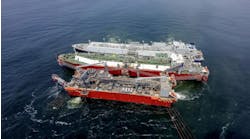Patrick M. MurrayDuring the past several years, many oil companies instituted vast organizational changes. These changes include redesigned work processes that have essentially redefined the way work is performed. One of the most notable changes has been the shift to multidisciplinary asset teams from functional work teams formed along the lines of technical disciplines, including geology and petrophysics, as well as drilling, production and reservoir engineering.
Sr. Vice President, Strategic Initiatives
Dresser Industries
The increase of asset-based teams has been a driving force that has contributed to the increase in demand for seamless, integrated products and services provided by oilfield service companies.
Within traditional oil company organizations, the discrete services offered by oilfield service companies and suppliers can be used to meet short-term objectives of tapping a field?s production at the lowest possible cost. The use of asset teams, however, shifts the focus of work teams from the short-term objective of simply finding the lowest cost to the longer-term objective of maximizing an asset?s value over its life cycle. Consequently, providing discrete services and products at just one, two or even three points in time during the life-cycle asset-management process no longer holds the same value and therefore, cannot always meet the needs of oil companies that employ the asset team model.
With the collective focus currently on maximizing asset value, multidisciplinary teams concentrate on seeking and implementing innovative technical solutions to increase overall asset net present value (NPV). In doing so, unique bundles of products and services are often contracted that generate overall NPV increases rather than just cost reductions and short term producing rate spikes.
Therefore, the focus on future operator/supplier contracts will shift from solely cost saving strategies to total solutions that maximize the NPV of the asset?s entire development and production programs throughout its life. Because seamless, fully integrated services have been proven to generate breakthrough increases in asset-NPV, they inherently provide more value to asset teams than do discrete services.
To provide the highest value to oil company asset teams, service companies are required to not only have an in-depth knowledge of drilling, completion and production technology, but to possess a comprehensive understanding of reservoir characterization and management-both key to maximizing an asset?s ultimate hydrocarbon recovery. While drilling, completion and production comprise the execution phase of field development, the knowledge phase involves gaining an understanding of the subsurface through reservoir characterization activities. Knowledge and execution are both needed to offer fully integrated services. In a sense, by having technical expertise only in execution, solutions are sought without a detailed understanding of the problem. Characterizing the reservoir provides knowledge to first define the problem, so that alternative scenarios can then be evaluated and optimum solutions executed or perhaps even new techniques developed specifically for the asset under management.
Defined as the set of activities at the front end of the upstream value chain, reservoir characterization includes seismic interpretation, well log analysis, and reservoir modeling - all of which can be used to optimize field development economics. Characterization of the reservoir drives the type of drilling and completion services required, providing service companies with the knowledge to think "outside the box." Technical knowledge through reservoir characterization activities yields added value in well construction design, drilling and completion, as well as production engineering execution.
Reservoir characterization has and will continue to be a competency of the major oil companies - particularly for the most attractive, highest potential new field development prospects. However, opportunities for oilfield service companies to participate in reservoir characterization activities will continue to emerge as asset teams desire integrated product and service offerings that generate NPV increases of the hydrocarbon assets for which they are responsible.
These opportunities will first be concentrated in mature, land-based properties. Though major oil companies may call on service companies to provide reservoir characterization expertise in their mature, less attractive basins, they will not be engaging in wholesale outsourcing of this core competency.
National oil companies and independents will also provide opportunities with their property holdings around the world. During high levels of industry activity, some major and even more national and independent oil companies may become resource constrained with in-house geophysical and reservoir engineering talent, thus preventing these companies from simultaneously pursuing all of their asset development opportunities.
Consequently, oilfield service companies will be called on to assist a large portion of national and independent oil companies with their reservoir characterization and field development activities. However, over the long term, reservoir characterization opportunities will most likely be concentrated in national oil company properties, because nationals own the overwhelming proportion of proved developed and undeveloped reserves.
Maximizing asset value is an ongoing process that begins at prospect discovery and does not end until the asset is depleted and subsequently abandoned. Experience has demonstrated the importance of proper planning in an asset?s development. The technical knowledge gained early on via reservoir characterization will help maximize ultimate recovery, and hence, the asset?s value, throughout its producing life.
This page reflects viewpoints on the political, economic, cultural, technological, and environmental issues that shape the future of the petroleum industry. Offshore Magazine invites you to share your thoughts. Send your manuscript to Beyond the Horizon, Offshore Magazine, Box 1941, Houston, TX 77251 USA. Manuscripts will not be returned.Copyright 1998 Oil & Gas Journal. All Rights Reserved.


